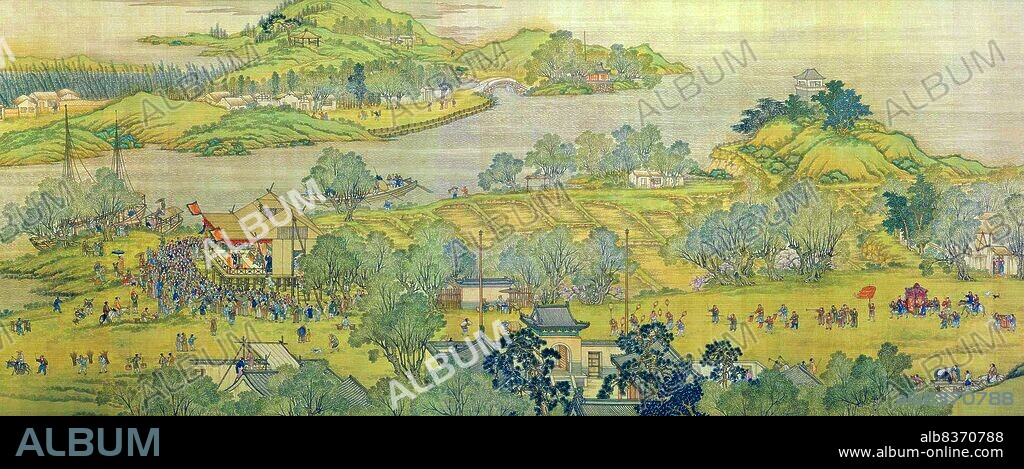alb8370788
China: Qingming Shang Tu< / i> or 'Along the River During the Qingming Festival' (detail), from a 1737 Qing Dynasty version based on the Zhang Zeduan (1085-1145) original scroll painting dating from the Northern Song Dynasty (960-1127)

|
Add to another lightbox |
|
Add to another lightbox |



Title:
China: Qingming Shang Tu< / i> or 'Along the River During the Qingming Festival' (detail), from a 1737 Qing Dynasty version based on the Zhang Zeduan (1085-1145) original scroll painting dating from the Northern Song Dynasty (960-1127)
Caption:
'Along the River During the Qingming Festival' is a painting by the Song dynasty artist Zhang Zeduan (10851145). It captures the daily life of people and the landscape of the Northern Song capital, Bianjing, today's Kaifeng. The theme is said to celebrate the festive spirit and worldly commotion at the Qingming Festival, rather than the holiday's ceremonial aspects, such as tomb sweeping and prayers.
. Successive scenes reveal the lifestyle of all levels of the society from rich to poor as well as different economic activities in rural areas and the city, and offer glimpses of period clothing and architecture. The scroll is 25.5 centimetres (10.0 inches) in height and 5.25 meters (5.74 yards) long. In its length there are 814 humans (of whom only 20 are women), 28 boats, 60 animals, 30 buildings, 20 vehicles, 8 sedan chairs, and 170 trees. The countryside and the densely populated city are the two main sections in the picture, with the river meandering through the entire length.
. The original painting is the most celebrated work of art from the Song dynasty. Due to this high artistic reputation, it has inspired several works of art that revived and updated the style of the original. The version presented here was made by five Qing dynasty court painters (Chen Mu, Sun Hu, Jin Kun, Dai Hong and Cheng Zhidao) and presented to the Qianlong Emperor on January 15, 1737.
. There are many more people, over 4,000, in the Qing remake, which also is much larger (at 11 metres by 35 cm, or 37 ft by 1 ft). The full scroll should be viewed from right to left.
. Successive scenes reveal the lifestyle of all levels of the society from rich to poor as well as different economic activities in rural areas and the city, and offer glimpses of period clothing and architecture. The scroll is 25.5 centimetres (10.0 inches) in height and 5.25 meters (5.74 yards) long. In its length there are 814 humans (of whom only 20 are women), 28 boats, 60 animals, 30 buildings, 20 vehicles, 8 sedan chairs, and 170 trees. The countryside and the densely populated city are the two main sections in the picture, with the river meandering through the entire length.
. The original painting is the most celebrated work of art from the Song dynasty. Due to this high artistic reputation, it has inspired several works of art that revived and updated the style of the original. The version presented here was made by five Qing dynasty court painters (Chen Mu, Sun Hu, Jin Kun, Dai Hong and Cheng Zhidao) and presented to the Qianlong Emperor on January 15, 1737.
. There are many more people, over 4,000, in the Qing remake, which also is much larger (at 11 metres by 35 cm, or 37 ft by 1 ft). The full scroll should be viewed from right to left.
Credit:
Album / Universal Images Group / Pictures From History
Releases:
Model: No - Property: No
Rights questions?
Rights questions?
Image size:
5100 x 2074 px | 30.3 MB
Print size:
43.2 x 17.6 cm | 17.0 x 6.9 in (300 dpi)
Keywords:
1737 • ART • ARTS • ASIA • ASIAN • BIANJING • CARTOUCHE • CHINA • CHINE • CHINESE • FESTIVAL • FESTIVITY • KAIFENG • LEGEND • NORTHERN SONG • PAINT • PAINTER • PAINTING • PARCHMENT • PORCELAIN • PULLEY • QIANLONG • QING DYNASTY • QING • QINGMING FESTIVAL • QINGMING SHANG TU • QINGMING • ROLL • SCROLL • SONG DYNASTY • SONG • ZHANG ZEDUAN
 Pinterest
Pinterest Twitter
Twitter Facebook
Facebook Copy link
Copy link Email
Email

